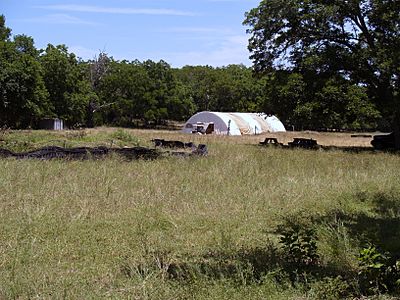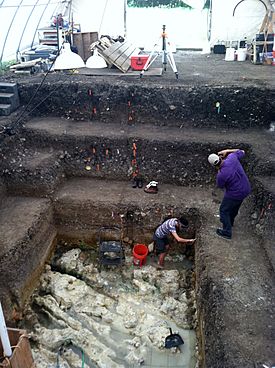Gault (archaeological site) facts for kids
The Gault archaeological site is an extensive, multicomponent site located in central Texas, United States, about 40 miles (64 km) north of Austin. It bears evidence of almost continuous human occupation, starting at least 16,000 years ago—making it one of the few archaeological sites in the Americas at which compelling evidence has been found for human occupation dating to before the appearance of the Clovis culture.
Significance
Probably the major issue troubling American archaeology over the last several decades has been establishing when the first humans arrived in the western hemisphere. For nearly half a century the large majority of working archaeologists adhered to the notion that people making and using the distinctive Clovis "point" and its associated lithic technology were the first to arrive about 13,500 calendar years ago and to have spread quickly throughout the Americas. However, there was always a small archaeological minority who contended that the first Americans (in the broadest, two-continent, sense) had been here long before Clovis times on both the east and west margins of both continents. In the last several decades, with the location, investigation, and reporting of a growing number of sites with reliable dating, more and more American archaeologists now believe the western hemisphere was occupied at least several thousand years prior to the appearance of diagnostic Clovis materials.
Most of these sites are widely spaced geographically and do not contain an extensive array of associated lithic materials that would show a diagnostic pattern of tool production and use. An attempt to define the characteristics of these older technologies can best be accomplished by investigating sites which are both well-stratified, containing both the older and Clovis materials—in order to compare technologies in use in the same location under similar conditions—and show evidence of extended periods of occupation where a wide range of activities took place employing the whole array of lithic tools.
The Gault site contains strata which date to prior to the appearance of Clovis (more than 13,500 years B.P.) and to Clovis (13,500 to 13,000 years B.P.), as well as the entire subsequent occupational sequence of the Central Texas region, from late Paleoindian (13,000 to 9,000 years ago) to Archaic (9,000 to 1200 years B.P.), and finally to Late Prehistoric (1200 to 500 years B.P.). A reason for this intensive and almost continuous occupation appears to be the site's location adjacent to two different but resource-rich ecosystems (the uplands of the Edwards Plateau and the lower Blackland Prairie) where water from Buttermilk Creek was available even in drought years, and where a wide variety of local food resources was concentrated. Another is that Gault was also a quarry site, where good quality Edwards chert toolstone (the Edwards Plateau is geologically one of the largest chert bearing formations in North America) was readily available, weathering out of the banks of both modern and ancient watercourses; chert from the Edwards Plateau has been identified as being used for toolmaking as far away as the Lindenmeier site in Colorado.
Additionally, the Clovis presence at the Gault site occurs in unprecedented abundance. A preliminary count of Clovis artifacts at the site numbers around 650,000 (including flakes, cores and formal tools), suggesting that a large number of people aggregated at the site and/or people resided at the site for an extended period of time. This evidence calls into question the traditional view of Clovis groups as highly mobile, dedicated big game hunters. Additionally, faunal material from the Gault site includes an array of large, medium-sized and small game such as mammoth, bison, horse, deer, rabbit, birds, and turtles, suggesting a generalized diet.
One of the most significant finds at the Gault site is that it is one of only twenty mammoth kill sites in the United States.
The national significance of the Gault site was recognized on May 29, 2018, by its official listing in the National Register of Historic Places. The site is also registered as a Texas State Antiquities Landmark.
History
Henry Gault, from whom the site takes its name, put together a 250-acre farm in the Buttermilk Creek Valley, starting in 1904. At some point in the early 20th century he found extra income as an informant for early archaeological explorations in Central Texas working with the first professional archaeologist in Texas, J.E. Pearce, as well as avocational archaeologists (Alex Dienst, Kenneth Aynesworth and others).
The first excavations were carried out at the Gault site in 1929, by Professor J. E. Pearce of the University of Texas. He was attracted by the large size and prolific artifact content of the Archaic midden at Gault. Letters in the Pearce archives contain reference to extensive looting at the Gault site in 1929, and this continued (it was actually a "pay-to-dig" site for many years) until 1998, when new owners stopped the practice. Fortunately, the looters and collectors apparently rarely dug into the earlier deposits below the Archaic midden due to the lower density of collectible or marketable artifacts.
Limited test excavations were conducted in 1991, and sustained geoarchaeological investigations began in 1998, and continued through 2002, and from 2007 to 2015, under the auspices of the Texas Archaeological Research Laboratory at the University of Texas at Austin, the Gault School of Archaeological Research (GSAR)[1] and the Prehistory Research Project at Texas State University [2]. In 2007, the site was purchased and donated to The Archaeological Conservancy [3]. Currently a majority of the site is managed and administered by the GSAR on behalf of the Conservancy and tours and educational opportunities are available.
Excavations
Excavations have been conducted in 15 areas, augmented by numerous machine-dug trenches and boreholes as well as the use of non-invasive geophysical procedures. The work in 1998–2002 focused on relatively undisturbed, early deposits beneath the looted midden. A sequence of cultural materials from early Paleoindian to early Archaic times was documented, including the technology styles identified as Clovis, Folsom, Wilson, St. Mary's Hall, Cody, Golondrina, Barber, Angostura, Hoxie, and Gower. Clovis was by far the most abundantly represented of these manifestations. Of the 11 cultures possible to find represented on archaeological sites in central Texas, the Gault site has samples of all 11.
Excavations in 2007–2014 in Area 15 of the Gault Site specifically targeted an occupation predating Clovis, evidence of which had been seen in two test units dug in 2002 and 2007. The excavation of a large block of Area 15 (48 m2 (520 sq ft)) penetrated 3.5 m (11 ft) from the surface to bedrock through culture-bearing alluvial fill eventually exposing 12 m2 (130 sq ft) at bedrock. Unexpectedly, part of this area had escaped the looting and collecting and had intact archaeology just below the surface. Physical and cultural stratigraphic evidence as well as luminescence dating are consistent in showing a coherent sequence of lithic material evidencing this older occupation followed by Clovis, Late PaleoIndian, Early Archaic, and Middle/Late Archaic occupations over an apparent span of more than 16,000 calendar years.
Tools numbering in the thousands were removed from the site before professional excavations began, however a large quantity of tools and debitage remained. Currently, the number recovered is estimated at ca. 2.6 million from 3% of the site. This includes artifacts from all the main cultural periods in Central Texas with the largest quantities belonging to the Clovis-age (more than 600,000 artifacts) and a significant number (150,000 - "The Gault Assemblage") of artifacts from the intact older strata. The findings from this part of the excavation are described more fully in "Evidence of an early projectile point technology in North America at the Gault Site, Texas, USA." A 2 by 3 m2 (22 by 32 sq ft) pavement of at least Clovis age with surrounding debris may represent early evidence of a structure or dwelling. More than 100 incised stones and one engraved bone have been recovered and the oldest, dating from the Clovis period, may represent the earliest portable art from a secure context in North America.



